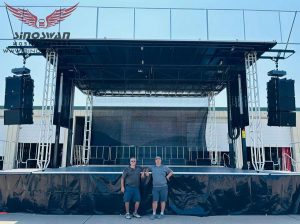The complex and fast-growing industry of events and entertainment requires a constant search for new and improved solutions, where flexibility and convenience are the main drivers. One such solution is the mobile stage – a multipurpose, highly mobile surface that re-imagines the layout and temporality of events. Some advantages relate to the fact that the mobile stages are easy to transport and can be quickly set up, which makes them popular for use during festivals, concerts, corporate events, etc.
A mobile stage is a transportable platform that is often used in events, acting performances, or other related activities. It often already has permanent installations and facilities, including lights, sound, and flying capabilities. The stages have the primary feature of being easily erected and transportable from one location to another as this is convenient for many occasions.


Trailer-Based Stages: These stages are portable since they are mounted on a trailer to enable moving them to different places. They can also be mobilized quickly and typically will already be equipped with features like ramps and sidewalls.
Modular Stages: A modular mobile stage is a stage that is divided into several sections that can be joined and disconnected from one another. This type allows variability of the stage that may include the height and sizes to suit the needs of events.
Pop-Up Stages: Pop-up stages are often democratically planned for quick construction and dismantling. They are normally employed on small occasions and are appreciated for their flexibility and movability.
Ease of Transportation: Mobile stages are particularly built to be transportable by a trailer or by a truck if necessary. Their logistical benefit is the fact that they can be easily carried when folded or disassembled.
Quick Setup and Breakdown: Another benefit of stages is the fact that when they are being erected or disassembled the procedure is fairly swift. This efficiency is vital for functions that are scheduled to take place in a short time.
Built-In Equipment: Some mobile stages include fixtures for lights, PA systems, and rigging features in their design. This integration saves the need for extra equipment, and also the training is easy to perform.
Customization : It is usually easy to find stages that can be hired and altered to match the requirements of the event. This can involve altering the width, height, or both of the stage, increasing the number of features on the stage, or incorporating branding features.
Music Festivals: The stages are popular in many concerts such as music festivals where there are several performances in a single day. This feature enables them to change readily from one act to another.

Corporate Events: The stages can also be used for major product launches, conferences, and corporate team-building activities. The stages allow for numerous configurations to enhance event experiences, including keynote addresses or even town halls.
Community Events: The mobile stage is widely used in local fairs, parades, and public celebrations to entertain people in public settings. This feature comes in handy for such events since it is easy to set up and bring down as well.
Theater and Performing Arts: The stages are common among theater companies and performing groups in events where they hold their performances outdoors or transport their performance to other places. As mentioned before, the stages can suit different staging needs as they are not limited to one type of construction.
Flexibility: It is a major plus that the stage can be relocated and adjusted to different theatres. It is most beneficial for a situation where things happen in diverse or transient environments.
Cost-Efficiency: Sinoswan’s mobile stages are beneficial when it comes to cost since they can be used in different places for various activities work, eliminating issues with renting different places and constructing stages.
Speed: Modular and temporary stages are quickly assembled and disassembled thus eliminating many inconveniences. This speed is particularly important in event operations that are on relatively short schedules.
Accessibility: The stages can be placed In areas where normal stages may not be quite useful; for instance, in areas that are outdoors or have scantily developed infrastructures.

Weather Dependence: Outdoor stages, as can be deduced from the structure, are vulnerable to the vagaries of the weather. It is important to provide sufficient measures and contingencies to keep the stage viable and safe.
Space Limitations: Although the stages bring such advantages as flexibility in location, size, and capacity may be restricted as compared with those of permanent stages.
Maintenance: The stage must be well maintained and checked periodically to avoid straining itself during the transport process and usage in the course of the performance.
Sinoswan’s mobile stages are a major advancement in the manner in which events are set up and managed. Some of the benefits associated with them include flexibility, transportability, and fast deployment, which makes them ideal for various occasions. Since the need for versatile event solutions has expanded continuously, the stages will probably become a more prominent component in the event sector.